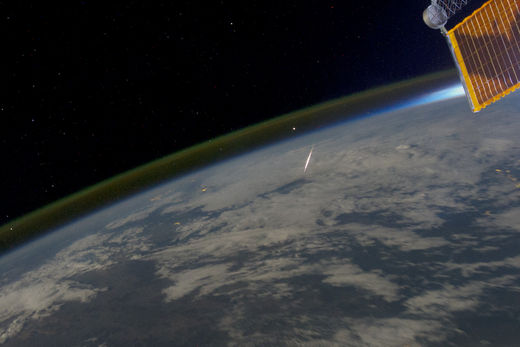
NASA are currently evaluating a similar spot of damage to one of the viewing windows on the International Space Station to see if that needs to be replaced.
The chip that left a visible scar on the outer pane was caused by a tiny meteoroid or scrap of space debris travelling many times faster than a bullet. It hit one of seven panes in the orbiting outpost's European-built Cupola - the space equivalent to a conservatory.
This particular impact is not thought to put the six astronauts on board in any danger. But it is a reminder that space is a dangerous place.
Astronauts aboard the ISS use the zone as a place to relax and watch the views of Earth and sky. It has provided some stunning images and videos recently of aurora displays and other spectacles including the recent Transit of Venus.
A protective shutter was quickly closed over the damaged window, which has four layers of glass. The outer pane on the Cupola, which was carried into orbit by space shuttle Endeavour in February 2010, can only be replaced with a spacewalk.
The astronauts currently on the ISS - Commander Oleg Kononenko and Flight Engineers Sergei Revin, Gennady Padalka, Joe Acaba, Don Pettit, and Andre Kuipers - took photos of the impact scar on Window Two of the Cupola and beamed them to mission control for analysis by experts.
NASA are monitoring the orbits of the thousands of larger pieces of space junk left by satellite collisions and "star wars" tests in space. But smaller fragments plus natural meteoroid fragments flying through space are a constant hazard.
Space debris expert Dr Lucy Rogers told Sen: "Space is full of tiny pieces of debris - both man-made and natural. It is estimated that there are hundreds of thousands of pieces of space debris, smaller than a cherry, travelling at speeds of up to 17,500 km/hr.
"The space station is protected in many ways from damage by these pieces of debris. The windows of the ISS cupola are made from fused silica and borosilicate glass and are therefore much more resiliant than normal windows on Earth. However, a small piece of space debris can still cause it to chip, in the same way a car windshield will chip if hit by a small stone on the motorway.
"Any chips that are seen on the cupola are reported directly to NASA, and the shutters of the orbital Debris Protection System (MDPS) on the Cupola will close. These shutters are made from aluminium and Kevlar/Nextel sheets, and will protect the astronauts should the pane of glass fail. NASA will carry out extensive investigations to ensure the integrity of the glass, before allowing the shutter to be opened again."
Dr Rogers added: "There are equations used to predict penetration depth of projectiles - these can be used to calculate the size and speed of the debris that hit the window. The scientists will also be interested to see if they can work out what it was that hit the window - was it a broken part of another satellite, or was it small natural meteoroid?
"This type of data helps the scientists and engineers calculate the probability of future micro-meteoroids and orbital debris (MMOD) strikes, and so precautions and safety measures can be taken to protect both astronauts and spacecraft. If a similar sized piece of debris had hit an astronaut on a spacewalk, the consequences may have been fatal."



Reader Comments
to our Newsletter